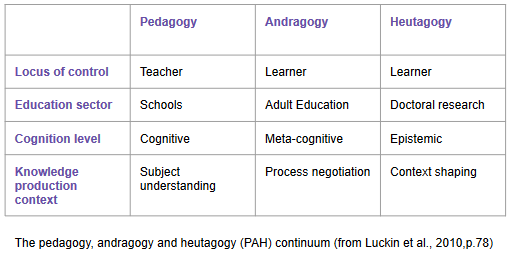Social learning in communities of practice

“The aim [of social learning] is to engage thousands of people in productive discussions and the creation of shared projects, so together they share experience and build on their previous knowledge” (Sharples, et al., 2014).
Several researchers make a link between social networking and problem based learning, recognising that in web communities learners are engaged in active exploration, negotiation and interpretation, and in constructing solutions together. The emphasis is thus on active knowledge building using collaborative technologies (Hung, 2002; Markham, 2003).
This moves away from teacher-directed pedagogy towards a flexible learner-directed approach. The Pedagogy-Andragogy-Heutagogy (PAH) continuum (Hase and Kenyon, 200; Luckin et al. 2010) offers a useful way of considering the redefinition of teacher-learner roles in this context.
Read more about self-directed learning here: Self-direction in learning and here Self-directed learning
References:
Hase, S. and Kenyon, C., 2000. From andragogy to heutagogy. Ultibase articles, 5(3), pp.1-10.
Hung, D. (2002). Situated cognition and problem-based learning: implications for learning and instruction with technology. Journal of Interactive Learning Research, 13(4), 393-415.
Johnson, C. M. (2001). A survey of current research on online Communities of Practice. The Internet and Higher Education, 4(1), 45-60.
Luckin, R., Clark, W., Garnett, F., Whitworth, A., Akass, J., Cook, J., ... & Robertson, J. (2010). Learner-Generated Contexts: A Framework to Support the Effective. Web 2.0-Based E-Learning: Applying Social Informatics for Tertiary Teaching: Applying Social Informatics for Tertiary Teaching, 70.
Markham, T. (2003). Project based learning handbook: A guide to standards-focused project based learning for middle and high school teachers. Buck Institute for Education.
Richardson, W. (2010). Blogs, wikis, podcasts and other powerful web tools for classrooms. Thousand Oaks, CA: Corwin, p. 133.
Sharples, M., Adams, A., Ferguson, R., Gaved, M., McAndrew, P., Rienties, B., & Whitelock, D. (2014). Innovating Pedagogy 2014.

